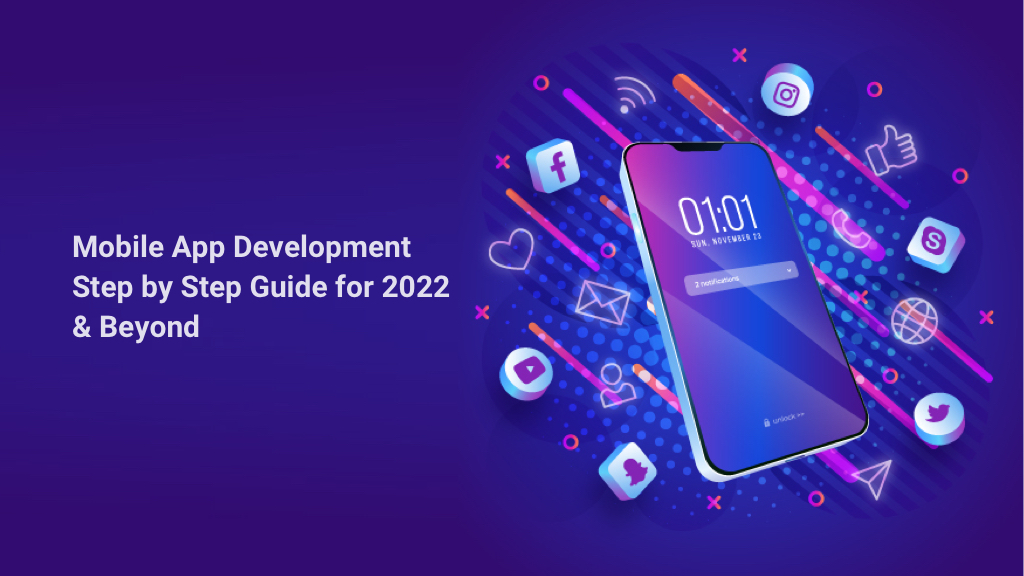Mobile app development – Step by Step Guide for 2022

Do you have a unique idea and looking to develop a mobile app in 2022? If so, then you need to know about the different stages of mobile app development. In this blog, we will discuss the mobile app development process in 2022.
As we all know, the mobile app development process is constantly evolving. In recent years, we have seen a lot of changes in the mobile app development process. With the advancement of technology, the mobile app development process is also becoming more and more complex.

So, if you are planning to develop a mobile app in 2022, then you need to be aware of the different stages of mobile app development.
Step-by-Step Mobile App Development Process
Validate your app idea
When it comes to developing a new app, the first and most important step is to validate your idea. This means making sure that there is a market for your app and that it will achieve your business objectives.
To do this, you need to answer the following five questions:
- What is the primary goal of your app?
- What problems will be solved by your app?
- Who is the target audience?
- How will your app be different from other existing apps?
- What is your budget for developing the app?
Answering these questions will help you to determine whether or not your app idea is worth pursuing. If you can’t answer them, then it’s likely that your idea is not ready for development.
Once you have validated your app idea, you can then begin the process of development. This includes things like market research, creating a prototype, and finding a development team.
Project Requirement Discussion
If you’re clear about the intent of your mobile application development, the next step is to discuss project requirements with an expert. This will help you determine the mobile app development platforms that are right for your project. Keep in mind that your target audience is a key factor in deciding which platforms to use.
For a quick overview of the percentage of Android & iOS mobile users across the globe, check out this link: www.link.com/audience-overview.
This information will be helpful in deciding which platforms to use for your mobile application development. Once you’ve decided on the platforms, you can move on to the next step in the process.
Business Insight and Estimation
As you move forward with your app development project, it’s important to have a clear understanding of the business insights and estimation. This will help ensure that your project stays on track and within budget.
There are a few key factors to keep in mind when estimating the cost of developing an app:
The complexity of the app. How many features will the app have? Will it be a simple app with a few basic features, or a more complex app with a lot of bells and whistles?
The size of the team. How many developers will work on the project? A larger team will obviously cost more than a smaller team.
The platform. Will the app be developed for iOS, Android, or both? Each platform has its own set of costs and considerations.
The duration of the project. How long will it take to build an app? A longer project will obviously cost more than a shorter project.
Keep these factors in mind as you discuss the business insights and estimation for your app development project. With a clear understanding of the costs involved, you can ensure that your project stays on track and within budget.
Signing NDA
Before you begin your mobile app development, it’s important to sign an NDA with the software firm you hire. This will ensure that all details of your app development are confidential and protected.
Top app development companies always sign NDAs before starting development. The NDA carries every detail for your app development. And the NDA is signed by both you and the company that gets bound to provide you with everything present in the NDA.
To make it more clear to you, here are a few points that must be considered in your NDA:
– The in-depth requirement of your app development project
– The company’s commitment to protecting your confidential information
– The consequences of breaching the NDA
By signing an NDA, you can rest assured that your app development project is in good hands and will be treated with the utmost confidentiality.
Wireframing of the App
Wireframing is an important step in the mobile app development process. It allows you to create a blueprint of your app, which can be used to guide the development process. There are a variety of tools you can use to create wireframes, such as Balsamiq, Gliffy, and Omnigraffle.
Creating a wireframe will help ensure that your app is developed according to your vision. It is also a valuable tool for communicating your ideas to developers and other stakeholders.
If you are looking to develop a top-quality app, it is essential to create a wireframe. Doing so will help you save time and money in the long run.
UI/UX Design
The app development company you choose will have a big impact on the success of your app. The company you choose should be able to create an app with excellent UI/UX design. The app development company you choose should be able to create an app that is interactive, intuitive, and user-friendly. The app development company you choose should be able to create an app with a polished look. Choose the right app development company, and you will be on your way to a successful app.
The app development company you choose will have a big impact on the success of your app. The company you choose should be able to create an app with excellent UI/UX design.
Developing Your Mobile Application from Scratch
The app development process typically starts with defining the technical architecture, picking a technology stack, and defining the development milestones. Mobile app development often requires integration with external APIs, which can rapidly integrate, use, and consume the most common app capabilities. These include authentication services for user sign-up / sign-in, push notifications, payment processing, and location tracking.
When developing an app, it’s important to consider the user experience (UX) and user interface (UI). A great app will have a well-designed UX that makes it easy for users to accomplish their goals, and a UI that is visually appealing and easy to use.
App development companies can help you with all aspects of app development, from defining your requirements to designing and building your app, to testing and launching it. Contact the best app development agency today to get started on your app project.
Complete Software Testing Before Launching
Application testing is a process use to assess the functionality, accuracy, and compliance of software. It is an essential part of the software development life cycle (SDLC), as it helps to identify errors, bugs, or defects before the software is deployed in production.
There are various types of testing that can be perform on software, such as unit testing, integration testing, system testing, and acceptance testing. Each type of test has a different purpose, and all are important in ensuring that software is of high quality.
Tools that can be used for testing include static analysis tools, which analyze code without executing it, and dynamic analysis tools, which test code by executing it. The testing process generally involves writing test cases, running the code, and then verifying the results.
It is important to perform testing throughout the software development process, as it can help to identify errors early on. This can save time and resources in the long run, as it is often more difficult and expensive to fix bugs that are found later in the development process.
Performing adequate testing can be challenging, as there is always a trade-off between the time and resources that are invested in testing, and the quality of the software that is produced. However, it is always better to err on the side of caution and invest more time and resources in testing, as this will ultimately result in a better product.
App Launching & Post Deployment Support
After an app has been built and launched, it’s important to provide post-launch support in order to ensure that the app is accept by users and continues to function properly. App maintenance includes bug fixes, security updates, and performance enhancements.
It’s also important to continue to monitor the app for changes that need to be made in order to keep users engag. This can include adding new features, removing outdated features, and changing the overall design of the app.
User feedback is essential in order to determine what changes need to be made. In order to get user feedback, you can use app store reviews, social media, surveys, and other feedback mechanisms.
It’s important to address user feedback in a timely manner in order to keep users happy and ensure that they continue to use the app.
Post-launch support is essential for any successful app. Without it, an app is likely to quickly become outdated and lose users.
Conclusion
As we move into the future, the app development process is only going to become more and more important. With the rise of new technologies and the ever-changing landscape of the mobile app market, it is essential for app developers to stay ahead of the curve. By understanding the different stages of app development, app developers can ensure that their apps are successful now and in the future.
While the app development process may seem daunting, it is essential for app developers to understand the different stages in order to create successful apps.





